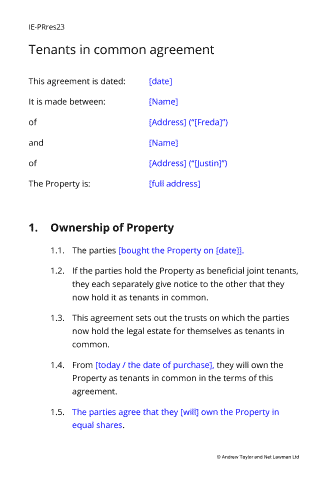Tenants in common agreement

Document overview


- Length:3 pages (400 words)
- Available in:
 Microsoft Word DOCX
Microsoft Word DOCX Apple Pages
Apple Pages RTF
RTF

If the document isn’t right for your circumstances for any reason, just tell us and we’ll refund you in full immediately.

We avoid legal terminology unless necessary. Plain English makes our documents easy to understand, easy to edit and more likely to be accepted.

You don’t need legal knowledge to use our documents. We explain what to edit and how in the guidance notes included at the end of the document.

Email us with questions about editing your document. Use our Lawyer Assist service if you’d like our legal team to check your document will do as you intend.

Our documents comply with the latest relevant law. Our lawyers regularly review how new law affects each document in our library.
Who should use this agreement
This agreement “severs” a joint tenancy, and sets out how the sale proceeds of real property will be split between the owners.
You may be married or in a relationship, and want to know that if you separate, when the property is sold you will each get out what you have put in.
You may be a couple, group of friends, brother and sister, or parent and child, buying a house together to get on the property ladder.
You may be buying for business purposes and simply not want the Land Registry to show your proportionate shares.
This is a simple agreement for owner occupiers. It is not suitable as the basis of a property venture for profit.
The law on co-ownership of property
In law, the relationship of co-owners of property is either as “beneficial joint tenants” or as “tenants in common”. The term “tenant” has no connection with a tenant under a lease. Under either sort of tenancy, a joint owner can insist on a sale.
Usually, your conveyancer will draw the document transferring your property to you in words that make you “beneficial joint tenants”. That means:
You own the property equally.
When you sell, the proceeds will be divided equally, even if one of you has contributed more in the meantime.
If one of you dies, the other(s) automatically get his share - even if you are divorced or separated, and regardless of what you write in your will.
This document changes that.
About this tenants in common agreement
This agreement serves two purposes.
First it “severs the joint tenancy”, so that each owner owns an identifiable share. This could be 50:50, or it could be any other ratio. That is legally valid, but will not change pre-existing obligations, for example, who is responsible for repaying the mortgage.
Secondly, it sets out the arrangements for division of the proceeds of sale of the property. Depending on the circumstances, that will be legally binding between the owners, but may not be binding against a third party, like a trustee in bankruptcy.
The agreement enables you to choose the ownership proportions or make arrangements for changing the proportions. For example, you may want a gradual increase in the share of one owner who is paying off a mortgage or parent-lender.
After you have signed this agreement:
Your shares in the property are separate in law, so that a creditor of one cannot take the share of the other too.
When you sell, the net proceeds are divided in the shares you have agreed.
If one of you should die, that person’s share will pass according to his will or intestacy.
Similar documents
This document does not contain arrangements for managing your property because it may become a public document. We cover management arrangements very thoroughly in other documents. Have a look at:
Joint ownership agreement: holiday property regulate the share ownership and use of a house, flat or other property for holiday occupation among different owners
Joint ownership agreement: residential property to record the joint ownership of a single residential property. Where all the owners occupy the property at the same time.
Cohabitation (living together) agreement sets out living arrangements, such as responsibility for bills.
Depending on your relationship, you may also want to consider a pre-nuptial agreement or a separation agreement to set out ownership of other assets.
Agreement features and contents
Suitable for situations where there are up to four owners (the maximum allowed by law)
Provides for a joint tenancy to be ended and changed to a tenancy in common

Recent reviews
Would highly recommend as it does exactly what it says using easy to understand language from a lay persons point of view. Thank you to all involved at Net Lawman. Daniel Doyle
I decided to buy from Net Lawman because the document was easily able to be edited to precisely what I needed, thus saving me the time and inconvenience of contacting a Lawyer to prepare everything.
The ease of it being able to be edited to include the conditions and terms required for my situation.
I have benefited by not having to employ a Lawyer to prepare the same document.
I thoroughly recommend Net Lawyer to anybody who requires easy to understand documents and advice in a hurry.
Dr. Douglas Majors
Choose the level of support you need
Document Only
This document
Detailed guidance notes explaining how to edit each paragraph
Lawyer Assist
This document
Detailed guidance notes explaining how to edit each paragraph
Unlimited email support - ask our legal team any question related to completing the document
- Review of your edited document by our legal team including:
- reporting on whether your changes comply with the law
- answering your questions about how to word a new clause or achieve an outcome
- checking that your use of defined terms is correct and consistent
- correcting spelling mistakes
- reformatting the document ready to sign
All rights reserved
